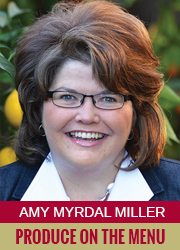 In my last column, I provided recommendations for selling produce to chefs in independent restaurants or small chains. In this column, I focus on the needs of larger operations, which have somewhat different needs — many focused on the delicate balance of controlling both food costs and labor costs. Insights for this column are based on interviews with members of The Culinary Institute of America Healthy Menus R&D Collaborative, including chefs from both large restaurant chains and large contract operations.
In my last column, I provided recommendations for selling produce to chefs in independent restaurants or small chains. In this column, I focus on the needs of larger operations, which have somewhat different needs — many focused on the delicate balance of controlling both food costs and labor costs. Insights for this column are based on interviews with members of The Culinary Institute of America Healthy Menus R&D Collaborative, including chefs from both large restaurant chains and large contract operations.
There are two themes that run through all the comments I received — communication and collaboration. If you work for a large grower/shipper/packer or distributor and you want to develop a long-term sales relationship with a big foodservice company, you first need to develop a relationship based on insights into both the common and unique needs of your customer.
Food Safety Comes First: So, what is on the minds and wish lists of chefs? At the top of everyone’s list is learning about innovations in food safety. What new technologies are you using for additional kill steps? What value-added processing can you do that will enhance food safety while also maintaining food quality?
Protecting and Enhancing Produce Quality: While many chefs talked about wanting extended shelf-life, some were also interested in enhancing product quality within the same shelf-life. Can the crispness of lettuce be maintained better through packaging technology? Can pre-sliced tomatoes be packed in a way to improve the final flavor and overall sensory experience?
Add Value, Save on Labor: Many went on to talk about their interest in value-added products that further reduce labor demands. Can you provide Romaine lettuce with the ribs and outer leaves removed? Can you provide fresh-cut vegetable blends in bowls with removable, reusable lids for smaller units? Can we partner to develop new products that will meet my needs?
Inferior Quality Is Sometimes OK: Another common request focused the ability of foodservice operators to turn imperfect produce into incredible ingredients. One chef asked, “Can I get access to cases of tomatoes that are too ripe to use fresh, but that I could turn into tomato sauce, at a great price?” Another chef quipped, “I don’t care what the fruit looks like if we’re going to use it in our smoothie or juice business. I just care what it tastes like.”
Local Sourcing and Marketing: Chefs who talked about local sourcing also talked about a desire to partner with suppliers to highlight local growers. “I’d love to have videos of the farms and farmers to share with our team members, as well as the people who dine with us.” Another said, “I’d love to partner with local growers who have ugly produce that we could use at a fair price. Looks don’t matter. We want great flavor, and we want to support local growers, but only when it makes sense for our operations.”
Ongoing conversations with your customers can reveal what’s working well, and more importantly, what’s not working well in their operation.
Limited-Time Offers: While year-round, consistent supply is a top priority for most operators, some want to explore partnerships focused on LTOs (limited-time offers) and promotions of menu items that create excitement and drive purchase intent for many operations. Do you have a produce item that’s only available for a few weeks each year? Think about offering it to a foodservice partner who can create an LTO that matches your supply window.
Packaging and Pack Size: Another common request focused on pack size and the ability to split cases or specify a certain pack size without a significant price increase.
Bring insights and information. Does your company pay for consumer market research? If so, are you sharing with your customers and potential customers? While all big foodservice operations have marketing departments tracking trends, you may have information a chef’s marketing colleagues haven’t identified as a menu opportunity. Bring your insights into your sales meetings; better yet, bring a chef with you who can translate trends into menu concepts. Many chefs in large foodservice operations have very small R&D teams.
Things That Drive Chefs Crazy: Nearly every chef talked about things that drive him/her crazy, including stickers on fresh fruit. “Why can’t I get cases of fruit packed for foodservice? I don’t want stickers that my team members peel off.” Another chef talked about the fact that his baby field greens mix contains iceberg lettuce. “Iceberg is not a baby field green. Get it out of there.” One final rant focused on hearts of Romaine. “We pay a premium for hearts; why do we have to remove the outer leaves?”
On-going conversations with your customers can reveal what’s working well, and more importantly, what’s not working well in their operation. Responding quickly to customer challenges is a critical part of a long-term relationship that will help make both of your businesses more successful.
Amy Myrdal Miller, MS, RDN, FAND is a farmer’s daughter from North Dakota, award-winning dietitian, culinary nutrition expert, and founder and president of Farmer’s Daughter Consulting, Inc. Learn more about her business at www.farmersdaughterconsulting.com. Follow her insights on food and flavor issues on Twitter @AmyMyrdalMiller.



